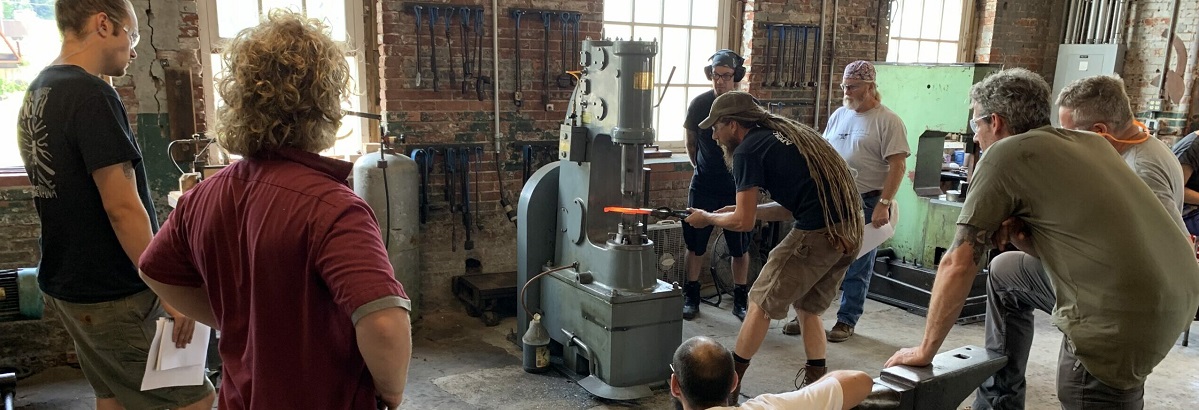
How to Become a Blacksmith – Make Your Dream a Reality
With blacksmithing once again cropping as a feasible career route, it’s the ideal time to consider an apprenticeship.
A blacksmith has tons of options in the type of work he or she can do. Conventional blacksmithing generally includes welding, forging, riveting, and repairing metal parts for use in farm machinery, along with industrial and domestic equipment. But the real renaissance happens in artistic blacksmithing, which is generally custom work in ornamental railings, furniture, and gates.
Blacksmithing degree requires obtaining the proper education/training, developing the necessary skills, and physical strength.
What is a Blacksmith?
It’s a professional who works with metals, like iron, shaping them into decorative or useful shapes. Blacksmithing is a highly skilled craft, and even though there aren’t as many of them, they still get respect and high prices for their services.
Why are They Called Blacksmiths?
The “black” alludes to the metals blacksmiths work with. These metals produce a layer of black or dark oxides as they’re worked.
“Smith” is derived from the word “smite,” which means to hit.
Why is a Blacksmith’s Shop so Dark?
A blacksmith’s shop, well-known as a smithy, is kept dark for the blacksmiths to assess the temperature of the metal they’re working by its color.
Metals go through several phases as they heat, and it’s crucial to find the perfect temperature for working to produce a strong and reliable metal piece. Workshops also tend to be quite noisy, from the hammering and hot from the forge.
What Does a Blacksmith Do?
Blacksmith shapes and joins metals to make items such as railings, wrought-iron gates, horseshoes, furniture, and tools. This’s performed by heating metal in a forge until it’s workable and soft. Then blacksmith hammers, bends, and cuts the metal into shape before it cools again.
The blacksmith could specialize in:
- Industrial work, making things like specialist tools, security grills or fire escapes;
- Artistic or architectural metalwork, including decorative ironwork, gates, sculptures, and furniture.
Depending on the kind of blacksmithing, this trade could include:
- Working with a furnace or forge;
- Utilizing traditional hand tools, such as hammers, grinders, drills, hydraulic presses, and air chisels;
- Using power tools like, center lathes, pillar drills, milling machines, and welding equipment;
- Working with different metals, such as steel, wrought iron, brass, copper, and bronze;
- Heating metal to the proper temperature so that it can be shaped;
- Joining metals together applying various blacksmithing tools and methods;
- Adding “finishings” to metal or products.
You may also specialize in artistic work, which would standardly include being self-employed as well as selling work at fairs, craft shows, and galleries, and doing the administration required for running a business. It would either involve creating original designs or producing pieces based on instructions from the customer.
Blacksmithing Supplies
Get the Latest Deals on Blacksmithing Tools
unbeatable prices // fastest shipping // free delivery available
Job Schedule
A blacksmith works up to 35-40 hours every week from Monday to Friday with occasional overtime. The work is physically demanding, including the heavy lifting of metal items and working in noisy conditions. The setting may vary between large engineering or mining workshops to a small-scale smithy. If self-employed or employed by a small business, the hours typically depend on your workload.
Work Environment
Forges vary in size from small to large engineering workshops. You would need to wear protective clothing such as boots, an apron, gloves, safety glasses or a visor, and ear defenders. This job, as we said, could be physically demanding. Industrial blacksmithing, especially, can include lifting, although you would use power blacksmithing tools for the heavier work.
What Do I Need to Become a Blacksmith?
To do this job, you’ll need to have proper hand-to-eye coordination and work skills. If you like working with tools and machinery and you enjoy being creative, then this job is perfect for you.
You may also be training for industrial blacksmithing by doing an apprenticeship in engineering, combining, training, for A.A or A.A.S degree in fabrication and welding with working for a blacksmith or specialist company.
Typical Day
Blacksmiths spend most of their day near a furnace or forge, heating, welding, and shaping different metal such as brass, steel, iron, bronze, and cooper, for assigned tasks. You’ll be using power tools and hand tools to get the work done efficiently. Once the basic shape of the object is created, you’ll use small chisels, tongs, and hammers to finish the product.
To harden the metal, it’s placed in the forge at high temperatures between 500 to 1300 degrees, then soaking it in cold water to bring it back to room temperature. The next step is tempering when the item is again placed in a forge and heated to a lower temperature to make it less brittle.
The final cooling of the metal item is performed at room temperature. In addition to making new products, you may also transform or repair existing metal products – this takes less time and effort.
ADDITIONAL ARTICLES
- Top 22 Blacksmithing Tools for Beginners
- Best Gunsmith Schools & Program Comparison
- The Ultimate Welding Guide
- 14 Most Used Welding Tools Today
- How to Become Professional Welder – Welding School, Training, And Certification
- Brazing – All You Have to Know
- 3 Best Ways on How to Braze Metal Like a Professional
- What’s the Difference Between Welding and Brazing?
- 7 Simple Techniques to Cut Metal
- The Super Practical Guide to Knife Blade Designs
How to Become a Blacksmith
To become a blacksmith, you must gain a basic high school diploma or its equivalent. You should also have a driver’s license and maintain a clean driving record as some part of the job includes traveling to the job site.
In recent times, some colleges let you complete a bachelor’s or master’s degree in blacksmithing. Also, you can look into vocational programs that offer blacksmith training and introductory coursework in blacksmithing history, working with hand and power tools, the terminology used in the industry, etc.
Essential skills to succeed in this trade involve an inherent talent and familiarity with metalwork, including forging and understanding how to shape and fix metal objects.
Knowing which metals are forged at certain temperatures and how to use hammers and chisels to work the metal is also a significant advantage. Such deep understanding can be obtained at an early stage by completing an apprenticeship with an experienced professional.

What Education Do I Need?
Certifications and formal are absolutely optional for blacksmiths in the vast majority of places. You can have a great career as a blacksmith without any formal education. However, attending a trade school or gaining a blacksmithing degree can put you more authority, especially while your workshop is brand new.
Choose blacksmith college that offers a wide assortment of courses, or trade schools with programs if you want to go through the formal education path.
Like most similar trades like metalwork or welding, most of your blacksmith education will really come in the manner of an apprenticeship where you can learn hands-on under the guidance of an expert.
Due to the other aspects of the business, like keeping track of finances and dealing with clients, it’s highly recommended to (at least) having your twelfth grade to become a blacksmith.
Where to Learn Blacksmithing?
Here you’ll find a brief overview of blacksmithing schools that are available within the USA.
Center for Metal Arts
The Center for Metal Arts has focused on expanding its course offerings and capabilities. This school also provides housing for those traveling in for classes. This is an excellent blacksmith school in the historical setting of Cambria/Bethlehem Steelworks. Levels range from beginner to advanced professional; they also offer residency programs as well.

Virginia Institute of Blacksmithing
Placed in Waynesboro, Virginia, the Virginia Institute of Blacksmithing offers a full schedule of courses who are beginning blacksmithing to advanced. They also provide a certificate for Artistic Blacksmithing, which is a 1-year program containing 12 modules.
This institute has 16 student forging stations, and classroom space situated in 4000 sq. ft. of the South River Mill Complex.

Cleveland Blacksmithing
Located in Cleveland’s district, Ohio city, Cleveland Blacksmithing offers a variety of classes and weekend workshops.
Run by Brooke and Gavin Lehman, they’re excited about teaching a passing along the skill of the blacksmithing. Its membership offering is a great way for practicing and learning blacksmithing continually.

Turley Forge Blacksmithing School
Settled in Santa Fe, New Mexico, Frank Turley founded the Turley Forge Blacksmithing School in 1970. Even though Frank is now semi-retired, his passion lives on as the school still stays busy with loads of class offerings.
With more focus on longer classes or workshops, this blacksmithing school provides students enough time to learn a lot before going back to its own forge.

New England School of Metalwork
A local welding distributor, Maine Oxy, from Auburn, Maine founded the New England School of Metalwork in 2000.Thanks to continued growth, what started in a dual-purpose building, offering welding and blacksmiths’ courses, is now split into two separate buildings, letting more variety in its course offerings and better tool dedication to each program.
Their facilities include 8 complete hand-forging stations, along with a couple of power hammers, and a forging press. As an extra benefit, they also offer dorm-style housing on-site, if you’re traveling in to take classes.

Where Can I Work?
You can be expected to be hired by various institutions like museums, galleries, architectural firms, and more. Businesses like metal fabrication and manufacturing are also on the radar for qualified blacksmiths.
Ornamental blacksmiths often give their expertise to decorative items at small retain shops for sculptures, crafts, chandeliers, fireplace pokers, and weather vanes. Vocational schools and certification courses on metalsmithing often hire blacksmiths to instruct students on the subject area.
Job Outlook
As a blacksmith, you can find many opportunities for growth in sectors such as manufacturing, agriculture, wholesale trade, as well as building and construction. Enough experience will take you to supervisory roles or launching a business.
New positions and high turnover from existing employees leaving are expected to ensure more openings for potential blacksmiths. Some blacksmiths are shifting into working as a farrier – a job that factories can’t replace – which includes crafting and fitting horseshoes.
With sufficient experience in the trade, you can also be an ornamental blacksmith in the arts/crafts industry, making tailored products for clients like metal tools, iron furniture, ornaments, artwork, and wall décor.
Salary
The average annual wage of a blacksmith varies, depending on how skilled you are and what you specialized in. Evidently, a very skilled blacksmith will be able to get a much higher wage than a mediocre blacksmith.
The location will also usually play a part in a blacksmith’s wages; some areas have a higher demand for blacksmiths; therefore, they’ll usually be paid more. Blacksmiths that are in structural metal fabricating made roughly $38,590 in 2019.
The average annual wages of self-employed blacksmiths, on the other hand, can vary widely. According to recent studies, smiths that only work part-time can earn as much as $21,000 a year.
Ornamental smiths may be able to make a living salary, according to their skills and the demand for their creations. Still, there’s no set data regarding the annual wages of these sorts of artisans.
Blacksmith ID
- Job title – Blacksmith;
- Office – Extremely hot work area;
- Description – Work with tools and fire to shape steel and iron;
- Certifications/educations – Art school or apprenticeship are highly recommended;
- Necessary skills – Physically fit, creative with good hand-eye coordination;
- Potential employers – Factories, manufacturers, metal fabricators, etc.;
- Pay – $20.00 per hour.
Conclusion
If you’re creative and artistic and love to work with all types of metal by joining, hammering, tempering, welding, and finishing, as well as want to learn both metallurgy and design besides basic metalworking skills, then this may be a career worth trying.
